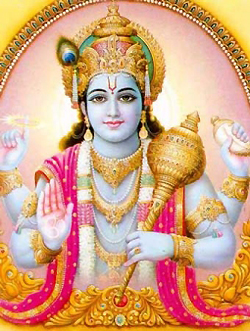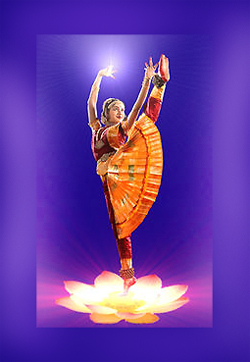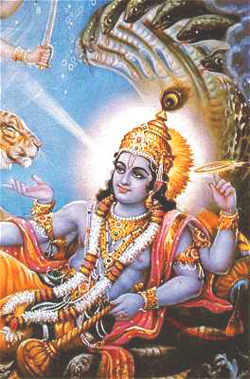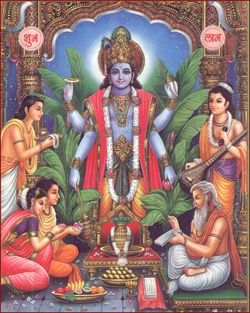VISHNU, the god of eroticism, dreams about the game of the world

Vishnu is one of the essential divinities of Hinduism. He represents the aspect of the Supreme Reality which maintains and sustains creation. The endless creative power of Brahma gives life to all beings, and the infinite force of maintaining of Vishnu protects this life. His worshippers, called Vaishnava, spread Vishnuism, which today constitutes one of the biggest spiritual orientations of the Hindu tradition. Like the Supreme Feminine Energy, Shakti, Vishnu has “a thousand names”, which symbolize all the many aspects or faces of him. Their daily repetition by his worshippers is a living proof of their belief and fervour.
“Vishnu, The maintainer, sustains everything in Creation and has the infinite power to manifest himself under an infinity of forms. In the great Cosmic Ocean, he supports himself both on the Son of the Infinite and on the ancient Spirit of existence, who is the Master of the Universe.” – Vishnu Purana
“Lakshmi is the adored lover of Vishnu; she is as beautiful as ten million Sun-rises and she is considered by many to be the embodiment of sensuality. With her charming eyes like lotus and decorated with garlands of lotuses, she is the eternal mistress of all beings. Lakshmi, filled with love, supports herself Vishnu’s thighs and she is the one who offers to the people prosperity in their life.”- Lakshmi Tantra
He keeps the primordial sound in a shell
There are numerous representations of Vishnu. Most of the time he appears in the form of a very beautiful young man with four arms (the multiplicity of his arms is always a sign of divinity which shows that they can realize more things in the same time). In one of the hands he keeps a shell, in another a disc, in the third he has a lotus and in the fourth he keeps a scepter. The symbolism of the shell has two aspects: his relation with the fundamental waters and the use as a musical instrument, reminiscent of the fundamental sound. The shell is also considered to be the emblem of the five elements, therefore the origin of manifestation.
The disc is a solar symbol, which represents in the classical image of Vishnu, the ascendant, unifying, intellectual tendency. The power to destroy ignorance and darkness meets in an explicit way with the symbol of the disc as a killing weapon, but also as the sun. He destroys evil, enlightening.
The lotus is a symbol of spiritual development and of cosmic harmony. The lotus is also a symbol of the primordial apparition of life on the neutral immensity of the primordial waters. The opening of the lotus bud represents the achievements of possibilities contained in the initial germ, the possibilities of the being. The scepter is a symbol of power and authority.
The colour blue represents the infinite, and the blue body of Vishnu signifies his infinite force. He is without name, without form, immeasurable. The yellow color is associated with the terrestrial energy, and the yellow clothes of Vishnu symbolize his incarnation on earth to maintain justice and destroy evil. The garland of flowers from around his neck is a symbol of the adoration of God. The precious stone which decorates his neck shows that Vishnu fulfills the desires of his worshippers, and the crown is a symbol of power and supreme authority of the Divine. The two earrings represent the dual nature of creation.
His vehicle is an eagle, Garuda, gifted with unusual powers, which spreads courage and Vedic knowledge. It is said that the bodily posture Garudasana puts us in telepathic resonance with Vishnu’s sphere of force.
His sky or his subtle sphere of force is the celestial city Vaikunta, built entirely out of gold. All the buildings are raised from jewellery, and in the centre of the city exists five pools filled with blue, red and white lotuses. Vishnu is seated on a gigantic lotus leaf, and next to him is found Lakshmi, his feminine counterpart.
The woman who adores him becomes all the women
 The goddess Lakshmi represents for the Hind success and prosperity. The word “Lakshmi” derives from the Sanskrit word “Laksya”, which means “purpose”, “goal”. She is the goddess of chance and wealth, both material and spiritual. Lakshmi is the goddess adored by the majority of the Hindi families, and especially by women. October is in a special way consecrated to adore her.
The goddess Lakshmi represents for the Hind success and prosperity. The word “Lakshmi” derives from the Sanskrit word “Laksya”, which means “purpose”, “goal”. She is the goddess of chance and wealth, both material and spiritual. Lakshmi is the goddess adored by the majority of the Hindi families, and especially by women. October is in a special way consecrated to adore her.
Lakshmi is described as being a very beautiful woman, sat on lotus flower. In her hand she has also a lotus bud, which symbolizes beauty, purity and fertility. Her four arms represent the four tendencies of human life: dharma, or honesty, kama or desire, artha or wealth (prosperity) and moksha or liberation. From her palms flow cascades of golden coins, suggesting that the ones who adore her will obtain wealth. She always wears red clothes with gold embroidery; red represents activity and gold – wealth. She is the goddess of prosperity, wealth, purity and generosity; she is the embodiment of beauty, grace and feminine charm.
She accompanies her lover in every incarnation on earth, multiplying in different aspects, to become the numerous wives of her Divine Lover. The mysterious capacity of a beautiful, vital and refined woman to become simultaneously “all the women” (to become multiple in her manifestations as daughter, wife, mother, lover, mistress, maiden, sister, etc.) for her lover represents a huge source of vital energy and in the same time represents an extremely refreshing and profoundly harmonizing contribution for a continent couple. We must introduce, through an inner transfiguration in the couple, the divine archetypes of Vishnu and Lakshmi in our daily lives. We must, also, develop conventional ways of adoring this divine couple through our love-making. We approach the multiple roles of the man and woman and visualize, with the help of our own creative imagination, the richness of these forms to explore and develop as much as possible our own erotic potential, thanks to the mysterious process of resonance that we unleash in our being through profound communion with these aspects.
He owns the secret of the sexual postures
The archetype couple Vishnu and Lakshmi, visualized in the practice of meditation techniques in a couple as god and goddess is identified with the highest aspects of the human soul. To live in spiritual communion with Vishnu and Lakshmi means to become one with the Master and Mistress of Maintaining, who are also the embodiment of spiritual richness and material prosperity. Vishnu and Lakshmi patronize eroticism, spontaneity, buoyancy, gaiety.
Hindu traditions tell us that the spiritual son of Vishnu and Lakshmi is the god of love, Kama, a kind of Indian Cupid. He sends his arrows with flowers on their tops with a bow made out of flowers and bees. Symbolizing the senses and the amorous game, this description of “the birds and bees” constitutes a conceptual variation of the occidental myth. Kama is extremely beautiful, because Shiva gave him eternal beauty and youth. He is the embodiment of the love between Vishnu and Lakshmi and is invoked especially in the spring and always during the amorous act. Kama is always called into the hearts of lovers, and the famous treaty Kama Sutra is actually his song. Rati, his lover, is the embodiment of endless refined sexuality and of amorous vitality.
According to the Vishnu Purana treaty: “Vishnu and Lakshmi are forever united through the ecstatic game of lover, and in this purpose, they take different shapes,their multiple exterior manifestations, being in endless transformation, talk about the intimate and profound communion between the two. They represent the Eternal Divine Lovers.”
Every time he brings to the humanity a spiritual message
 Vishnu is often represented sleeping on the surface of the causal ocean. He “dreams” the game of the world and in the same time offers different methods of maintaining and identifying with divine superior aspects, your own self essence (Atman), and this is realized choosing “the waves of bliss” from the great Cosmic Ocean of Existence.
Vishnu is often represented sleeping on the surface of the causal ocean. He “dreams” the game of the world and in the same time offers different methods of maintaining and identifying with divine superior aspects, your own self essence (Atman), and this is realized choosing “the waves of bliss” from the great Cosmic Ocean of Existence.
He is considered to also be the guardian of humanity, the keeper of dharma – he has the role to maintain divine order in the world. Every time when humanity decays in the spiritual plane, they incarnate on earth as an avatar, a divine model, to show people new ways of spiritual development. The ancient texts mention nine different incarnations of Vishnu in this world, which recall the old interpretation of the theory of evolution. His first incarnation was a fish, Matsya; second incarnation was a turtle, Kurma; the third one a wild boar, Varaha; the fourth one a lion; the fifth one a dwarf, Vamana; the sixth one a warrior, Parasurama; the seventh one a hero, Rama; the eighth one Krishna, the ninth one Buddha. The tenth incarnation, Kalki, will appear at the end of this epoch, Kali Yuga. It is said that he is the cosmic rider of the Apocalypse, who will come to destroy quickly the evil that exists now on earth.
He crosses the world in three steps
In the Vedas he appears like a solar god called “the one who acts” (from the verb vish – to act), although he did not manifest his action only through his famous “three steps” that permitted him to instantaneously measure the universe and his three worlds: physical, astral, and causal. These three steps are often considered to represent the rising, zenith and setting of the Sun. The zenith, “the supreme step of Vishnu”, designates the secret subtle land, of the happy ones.
The secret tantric teachings emphasize the role of a woman as initiator in the mysteries of transfigurative sexuality, incarnation of beauty, sensuality and harmonious vitality. The formidable power of a woman to initiate is enormous, consisting in the first place in her mental attitude towards sensuality which is then approached only from the spiritual sense. Assuming an active role and exploring boldly the entire series sexual secrets during the amorous act a beautiful, sensual, intelligent woman gives a great spiritual power to her lover.
This mysterious power, the highest form of Supreme Feminine energy, is a direct expression of opened intuition, she is in the same time an energy of wisdom, spontaneous and joy, and can eliminate all obstacles quickly, both for her and her lover. Such a woman must initiate her lover with boldness in her spiritual experience. The success resides in pure spontaneity, in her capacity to trust herself and to focus with trust on high ideals, in her sincere aspiration to offer “something which is unforgettable” to her lover. Her gigantic self-confidence is an essential condition in all initiating rituals and actually the goddess within every woman who is awakened thanks to the transfiguration processes is the one who initiates.
Vishnu in the Tantra tradition
 “The erotic aspect is Vishnu’s first secret; this is an eroticism related to the nourishing and cooling power of Soma (The Divine Nectar), to the element water and to the intuitive, natural wisdom of the senses. The oceanic sensuality of Vishnu’s sphere of action and influence opens the way through any conventionalism and allows rapid understanding and a natural and spontaneous expression of the diverse roles which the woman plays in creation.
“The erotic aspect is Vishnu’s first secret; this is an eroticism related to the nourishing and cooling power of Soma (The Divine Nectar), to the element water and to the intuitive, natural wisdom of the senses. The oceanic sensuality of Vishnu’s sphere of action and influence opens the way through any conventionalism and allows rapid understanding and a natural and spontaneous expression of the diverse roles which the woman plays in creation.
The numerous sexual amorous postures, assumed in a conscious way and free way, helps a lot to channel and sublimate in different layers of the microcosm of the human being the subtle sexual energy, and the secret procedures of the tantric teachings, which are correctly realized, permit the elevation and raising of the dominant level of consciousness through the complete transmutation of the sexual potential into energy and through the sublimation of these energies in the superior levels of the human being. Discovering the Paradise of Vishnu on the Earth, the devoted loving couple has the possibility to fully explore his true sexual potential.
The endless force of Vishnu manifests with the greatest power through the left side of the subtle body. Through this subtle channel called Ida Nadi, the circulation of the lunar energy (-) takes place through the human body. The characteristics are: humidity, receptivity, contraction, obedience, and modesty; when in subtle plan it is concentrated preponderantly in the brain, on the top of the head, on the level of Sahasrara, the endless maintaining force of Vishnu transforms the intuitive wisdom in continuous aspiration and ardent spiritual life. Vishnu’s force is mainly maternal, instinctive, imaginative and conventional.” – Fragment from “Sexual Secrets: The Alchemy of Ecstasy”, by Nik Douglas and Penny Slinger.
The intense erotic experience constitutes the fundamental “seed” of tantric spirituality. It is the pure emotion of love itself, the positive experience that stimulates the passions, inflames the senses and awakens the latent energy of Kundalini that dwells in the vital centre of sexuality, Muladhara Chakra. The erotic feeling is caused by the pleasant contact of the senses with the exterior world. When it is adequately refined, sustained and focused (sublimated) with wisdom, the transfigured Eros leads directly to transcendence and divine ecstasy. In the tantric tradition Vishnu is considered to be the master of eroticism and water.
This article was taken from Yoga Magazine
Read also:
Khajuraho: the temples of love
Tantra Yoga, a global and profound vision of reality
Yogaesoteric
October 2007


